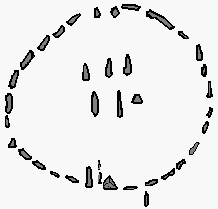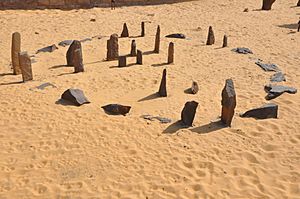Nabta Playa facts for kids
Nabta Playa was a big, ancient lake area in the Nubian Desert. It's about 500 miles (800 km) south of Cairo, in southern Egypt. Many ancient sites have been found there by archaeologists.
Contents
Early History of Nabta Playa
Around 10,000 BC, this area started getting more rain. This extra rain created a lake. Early people likely came here because there was water. They could feed their cattle where grass grew, and grass grew near the water.
Archaeologists, who are scientists studying old things, say the first people arrived between 10,000 BC and 8,000 BC. These people raised domesticated cattle and made ceramic pots. The pots had fancy patterns, possibly made with combs.
By 7,000 BC, more developed settlements appeared. People used deep wells for water. Their huts were built in straight rows. They also ate fruit, legumes, millets, sorghum, and tubers.
Later in 7,000 BC, there seemed to be more goats and sheep. These animals probably came from Southwest Asia. Many large hearths (fireplaces) were also found from this time.
Organized Life at Nabta Playa
Archaeological finds show that these prehistoric people lived in a very organized way. This was even more organized than groups who lived later near the Nile Valley. They built things using stones, both above and below ground. Their villages were carefully planned. They also dug deep wells that held water all year.
Findings show that people only lived here during certain seasons. They likely stayed in the summer when the lake was full, providing water for their cattle. Studies of human remains suggest these people might have moved from sub-Saharan Africa.
Ancient Beliefs and Egypt Connections
By 6,000 BC, there might have been an early religion or cult (a group with shared beliefs). They buried sacrificed cattle in stone-roofed rooms lined with clay. Some experts think this cattle cult at Nabta Playa might be linked to Ancient Egypt's Hathor cult. Hathor was a goddess often seen as a protector in desert areas at night.
Even though these cattle practices show possible links to Ancient Egypt, Egyptologist Mark Lehner said:
- It makes sense, but not in a simple, direct way. You can't go straight from these megaliths to the pyramid of Djoser.
This means that while there's some evidence, there's no direct proof that the cattle cult was directly connected to Hathor.
Nabta Playa: An Early Astronomical Site

By 5,000 BC, the people of Nabta Playa built one of the world's first known astronomical devices. It's about 1,000 years older than Stonehenge but similar in purpose. This stone circle may have been a prehistoric calendar that accurately marked the summer solstice (the longest day of the year).
Astrophysicist Thomas G. Brophy believes these monoliths (large stones) might tell us even more. The calendar circle has one opening facing north-south and another facing northeast-southwest, marking the summer solstice. It also has six stones in the center. Brophy's idea is that three of these center stones match the belt of the Orion constellation when it was at its lowest point in the sky. The other three stones match Orion's shoulder and head stars when they were at their highest point. This pattern repeats about every 25,000 years. The last time Orion's belt was at its lowest was between 6400 BC and 4900 BC, which matches the age of campfires found near the circle.
The stone circle at Nabta Playa was built exactly on what was then the Tropic of Cancer. This is the sun's farthest point north in the sky. Today, the Tropic of Cancer is about 23 degrees 40 minutes North.
Another large stone structure exists with a central stone and other stones further away. Brophy found that lines drawn from the central stone to these outer stones match where certain stars, marked by the calendar circle's center stones, rose in the sky during the spring equinox. By looking at the different distances of these stones, he found they matched the actual distances of the stars from Earth. He used a scale where 1 meter equaled about 0.799 light years.
Images for kids
-
Pottery bowl fragments in the British Museum from early Neolithic Egypt, Nabta, 7050–6100 BCE.
See also
 In Spanish: Nabta Playa para niños
In Spanish: Nabta Playa para niños




